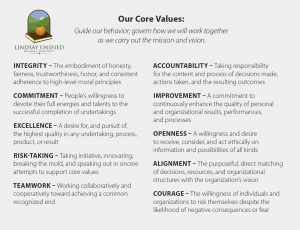Creating the Shared Purpose
CompetencyWorks Blog
 This is the sixth article in the series Implementing Competency Education in K-12 Systems: Insights from Local Leaders.
This is the sixth article in the series Implementing Competency Education in K-12 Systems: Insights from Local Leaders.
Creating a shared purpose requires districts to develop their capacity for facilitated conversations (i.e., the ability to listen deeply to each other while driving for an agreed-upon vision, statement, or solution). Districts have used a simple set of questions that generate robust conversations. For example, Lindsay Unified School District in California invested in deep community engagement to launch their transformative process, beginning with the questions:
- Why do we exist?
- What are the values that will govern how we interact with each other?
- What are the principles by which we will make decisions?
- What is our vision for the future?
- What is the description of our graduates?
The result is a mission of “Empowering and Motivating for Today and Tomorrow,” a set of core values and guiding principles that drive their instructional model.
In developing a shared purpose, Chugach School District had to engage communities from three different areas as well as a statewide homeschool community based all across Alaska. The resulting mission statement emphasizes student agency, mutual accountability, and cultural respect.
Bob Crumley recounts using the following process in meetings to initiate the Chugach shared purpose.
- Turn to a neighbor and tell each other your district’s shared purpose. Now, by a show of hands, how many were able to articulate our shared purpose? (In the beginning, there were few hands.)
- If, as leaders, teachers, and parents (depending on the group), we aren’t able to articulate our shared purpose, how are we going to work together to clearly articulate expectations and provide a roadmap for our students to achieve success?
- Ask students to think of a successful person (local, national, or international). Then begin a discussion on the following questions: What traits does that person have that helped them become successful? Which of those traits should we teach and assess to set all of our graduates up for success?
- Use the input to form the backbone for developing a draft shared purpose as well as informing student performance standards at a later stage.
Currently, Chugach School District operates according to the following shared purpose:
The Chugach School District is committed to developing and supporting a partnership with students, parents, community and business which equally shares the responsibility of empowering students to meet the needs of the ever changing world in which they live. Students shall possess the academic and personal characteristics necessary to reach their full potential. Students will contribute to their community in a manner that displays respect for human dignity and validates the history and culture of all ethnic groups.
That shared purpose of “empowering student ownership of learning and success” is supported by eight values (or elements) of performance-based learning, valuing stakeholders, resiliency, agility, shared leadership and responsibility, open and honest communication, continuous improvement and innovation, and trust and teamwork.
Creating the shared purpose is important; however, the real value comes in making sure it is used consistently. District and school leaders who have developed shared purposes, shared values, and guiding beliefs use them frequently to make decisions big and small during the transition years. According to Jamie Robles, Principal of Lindsay High School, “My job as a principal is to make sure our decision-making processes are managed effectively. At times I may need to step in to remind the team of our compelling purpose—our learners. When we have a shared goal, it makes decisions a lot easier. Collaboration is also a lot easier.” As Bill Zima, previously Principal at Mt. Ararat Middle School and now superintendent at RSU2, put it, “A process of facilitated conversations amongst all stakeholders led to the establishment of a philosophical lens through which all decisions pass.”
In order to engage the full organization in working toward a shared purpose, leaders need to be skilled in tapping into what drives adults. Bill Bryan, Center for Secondary School Redesign and a coach to educational leaders, explains that most adults are driven by task accomplishment, influence, or relationship needs. Educators are also often driven by intellectual curiosity and altruism. In order for leaders to engage administrative staff and teachers to direct their energy toward creating a new personalized, competency-based system and move outside of their comfort zones, they will need to understand the motivational drivers. Furthermore, they will need to develop a deep understanding of what underlying resistance is and employ the appropriate influence skills to help people overcome it. Thus, changing practices—introducing new ones and letting go of the old—is a leadership function, not management.
Equally important to engaging community members is to make sure educators are also fully engaged. Inquiry teams are important for educators to take the time to understand personalization, why it is important, how the traditional system is undermining their efforts, the implications for moving to a personalized, competency-based system, and how they can assess the way the school operates with a growth mindset or a fixed mindset. Some districts do not move forward until a large majority of educators in a school indicate they are ready. A case study on RSU2’s describes in detail the process the district took in considering a proficiency-based system, including a vote in the second year of the process in which the educators decided to move forward.
For more information, explore this whole blog series:
Blog #1 Introducing Implementing Competency Education in K–12 Systems: Insights from Local Leaders
Blog #2 What Is Competency Education?
Blog #3 Investing in Shared Leadership
Blog #4 Constructing a Shared Journey of Inquiry, Shared Vision, and Shared Ownership
Blog #5 Engaging the Community